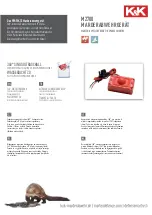
Cleaning and Passivation
Cleaning
32
Operating Instructions · VARIVENT
®
Mixproof Valve L with Lifting Actuator, suitable for pigging operation
Edition 26/08/2016
Cleaning and Passivation
Cleaning
All parts in contact with product must be cleaned at regular intervals. Always observe
the safety data sheets issued by the cleaning agent manufacturers. Only use cleaning
agents which do not cause damage to the seals and inner valve parts. During pipe
cleaning, the cleaning fluid also flows through the valve housings and cleans them.
With respect to the cleaning method and parameters like detergents, temperatures,
times and intervals, the component manufacturer can merely make recommendations
but cannot provide any generally applicable details. Method and parameters should be
determined and defined by the plant operator in accordance with the relevant process.
The cleaning effect must be checked regularly by the plant operator!
Cleaning process examples
Typical cleaning parameters in dairy operations
Example of a two-phase cleaning process:
•
Sodium hydroxide and combination products based on sodium hydroxide in concen-
trations from 0.5% to 2.5% at 75 °C to 80 °C.
•
Phosphoric acid or nitric acid and combination products based on these acids in
concentrations from 0.3 to 1.5% at approx. 65 °C.
Example of a cleaning operation in one cleaning step:
•
Formic acid and combination products based on formic acid at up to 85 °C.
Typical cleaning parameters in breweries
•
Sodium hydroxide and combination products based on sodium hydroxide in concen-
trations from 1% to 4% at approx. 85 °C.
•
Phosphoric acid or nitric acid and combination products based on these acids in
concentrations from 0.3 to 1.5% at 20 °C.
Cleaning effect
The cleaning effect depends on the following factors:
•
Temperature
•
Time
•
Mechanics
•
Chemicals
•
Degree of soiling
These factors can be combined in such a way as to make an optimal cleaning result
probable.
















































